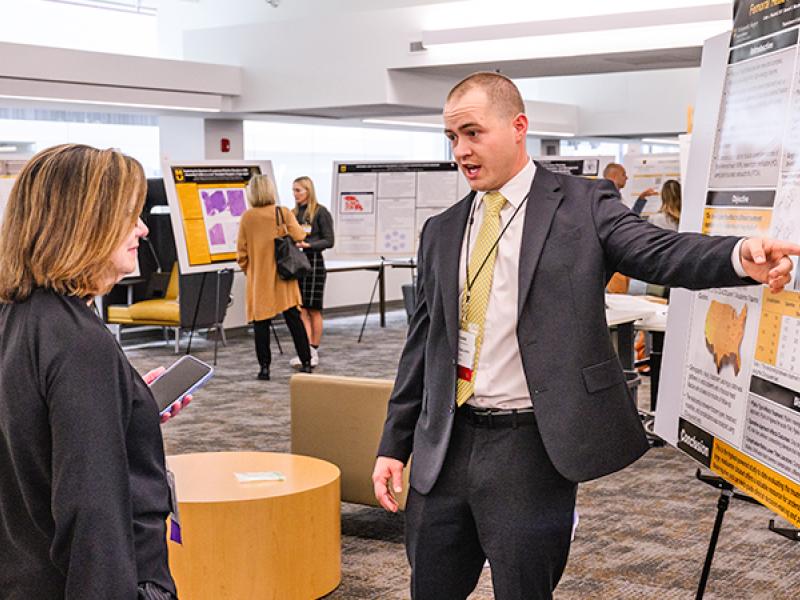Research
The MU Center for Translational Neuroscience serves as a home base for researchers from such programs as biochemistry, pathology and anatomical sciences, biological sciences, psychological sciences, neurology and neurosurgery.
Center experts serve as consultants and support teams for other scientists involved in related research.
Research cores include:
- Neurosurgery
- Cell Culture
- Neurobehavior
- Imaging Analysis and Neurohistology
Neurosurgery
The microsurgery core provides the surgical resources for basic and clinical scientists to implement different central nervous system disease models in rodents. This core includes the experimental equipment and facilities for proper anesthesia-gas delivery, temperature monitoring, blood and gas monitoring, laser Doppler measurement of blood flow and a high-power dissection microscope for microsurgery.
Animal models provide information about the effects of specific drugs or therapies on stroke damage, cerebral blood flow, vascular abnormalities, and Alzheimer's disease progression. Studies enable researchers to relate pathophysiology to behavior outcomes, to study the effect of single gene knock-outs on sleep, and to study the movement of brain tumor cells within the brain.
Cell Culture
Due to the diverse types of unique cells in the brain and their unique responses to challenges and injuries, it is important for researchers to have the ability to isolate primary and secondary cultures of nerve cells.
Current center expertise permits cultures of:
- Cortical neurons
- Hippocampal neurons
- Cerebellar granule neurons
- Striatal dopaminergic neurons
- Enriched neuronal cultures
- Mixed neuronal cultures
- Glial cells (astrocytes, microglia, oligodendroglia)
- Cerebrovascular cells (cerebro-endothelial cells)
- Human brain tumor cells
Behavioral Testing Core
Neurobehavioral testing is a critical component in studying brain function and in determining whether therapies and treatments have beneficial effects. Transitional and translational behavioral research from in vivo and in situ findings, and determining the relationship between neuropathology and neurologic effect is required to investigate disorders in model systems.
For example, molecular and cellular changes observed in bench work on Alzheimer's disease must be correlated with impairments in cognition and memory function, the key symptoms of the disease in humans. Similarly, evaluating sleep disorder models requires an isolated behavioral testing environment.
This core provides a consistent environment with carefully controlled noise, light and air circulation necessary for neurobehavioral testing. This facility will enable the following aspects of behavioral testing, which are of high-value to the neuroscience community:
- Cognitive evaluation including: Y-maze, passive avoidance, object recognition, fear conditioning response and Morris water maze. Valuable in research on Alzheimer's, aging, post-traumatic, stroke, Parkinson's
- Anxiety/emotional evaluation including: open field, elevated plus maze, light/dark neophobia and startle response testing. Valuable in models of neurodegeneration, stroke and sleep
- Complex behavioral testing including: social behavior, rotarod, pre-pulse inhibition testing, developmental milestones, ultrasonic vocalizations, open field and displacement reactivity testing. Valuable in research on autism, developmental disorders, schizophrenia
- Gait and motor function dynamics testing including: basso motor and beam walking, Von Frey threshold testing, 24-hour home-cage activity testing and strength testing. Valuable in models of neurodegeneration, stroke and spinal cord disorder.
- Sensory function testing, including hearing, vision, touch, and analgesia testing
- Sleep cycle evaluation, including REM and non-REM sleep
Imaging Analysis and Neurohistology Core
Current neuroscience research requires the ability to isolate findings to specific areas of the brain and identify the responses and signals from those specific areas. This core enables researchers to precisely visualize the smallest functional structures within the brain and provides the quantitative imaging capabilities to evaluate neuronal loss.
This core includes the following specialized equipment:
- A dedicated tissue processor for frozen cryostat section and fixing brain tissue
- A microtome for sectioning paraffin sections
- Equipment for immune-histochemistry and in situ hybridization
- Stereo and fluorescent microscope for image detection
- Cameras and software for stereomicroscopic image analysis





